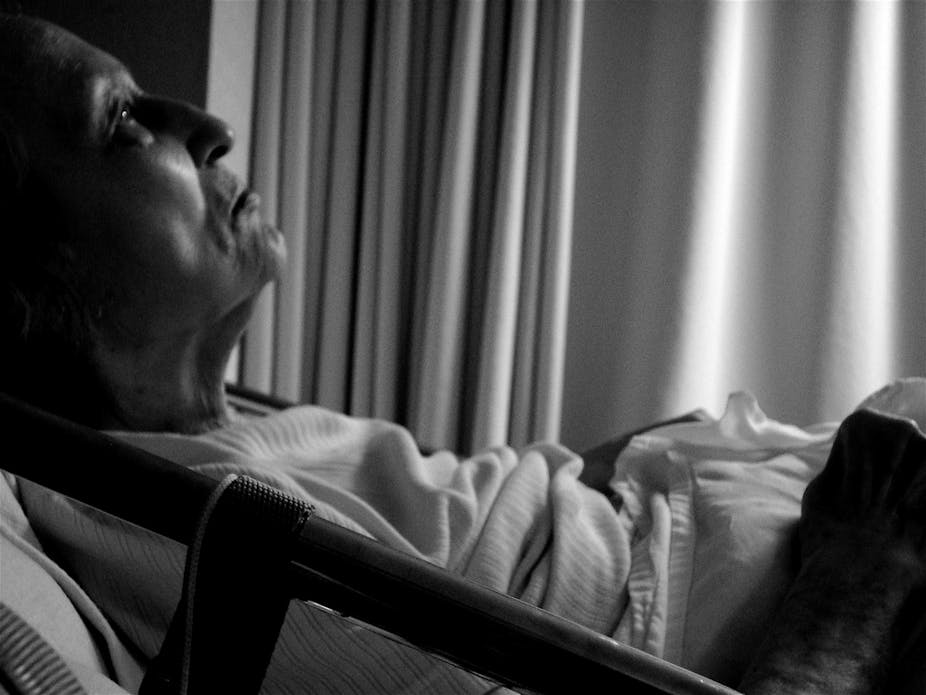Flu outbreaks in nursing homes can lead to pneumonia, stroke and heart attacks among elderly residents. Staff are a major potential source of infection, but only around one in five get an annual flu shot. Ensuring more get vaccines, and that doctors intervene early when an outbreak occurs, may be the key to saving lives.
Healthy adults respond very well to vaccination but ageing reduces vaccine efficacy so that in the elderly (over 80 years old) vaccines provide only about half the protection. This increased susceptibility makes the need to ensure that workers aren’t introducing infection even more pressing.
The case of aged care
The Intergenerational Report 2007 forecast that in 40 years there will be a 3.5-fold hike in health-care costs in real terms and a whopping quintupling in expense for aged care. A huge annual deficit of $35 billion is expected.
The proportion of Australians over 65 will double, and innovation in both commerce and medicine will be needed to prevent severe restrictions on essential medical and aged-care services.
Recent reports that aged-care facilities require more than 90% bed occupancy to remain viable throws into sharp relief the dilemma facing the large tranche of baby boomers entering their third age.
While they plan for a longer and better life, the stark truth is that this generation’s need for institutional care will rise inexorably over the next few decades.
The financial sustainability of nursing homes is threatened by considerable absences from work with the resultant expense of procuring agency staff. Finances are further stretched by reduced bed occupancy from hospitalisations, deaths and even closure to new admissions.
Effects of the flu
Every year outbreaks of influenza in aged-care facilities create major disruption. Generally, both the elderly and high-risk chronically ill adults are told to get their flu shots and usually they comply.
And yet only about 10% to 20% of nursing home staff nationwide has an annual flu shot. A randomised trial published in the British Medical Journal (BMJ) in 2006 showed that even being able to vaccinate half the staff can prevent half of all deaths during the flu season – a small outlay for a remarkable advantage.
Whether this can be achieved in Australia through mandating health worker vaccination, provision of a free immunisation service or linking to nursing home accreditation needs to be investigated.
Mandatory vaccination of frontline health-care workers against many infectious diseases, but not yet against influenza, is a New South Wales health policy.
Some argue that pneumonia from flu is the “old person’s friend” quickly carting off the frail who have poor quality of life.
But we are talking about someone’s mother, uncle or sister and even if they are well prepared and ready for death, we need to remember that influenza is much more than a personal issue – it’s a transmissible infection that requires treatment to control outbreaks.
What’s more, research shows that with effective treatment, many elderly survivors of severe pneumonia can have five or more extra years of productive, high-quality life.
Utilising research
Recent research in aged-care facilities has shown that using novel ways to actively identify influenza outbreaks in nursing homes can save lives and reduce hospitalisations.
Active surveillance involved bedside tests to diagnose influenza on the spot and prompt immediate treatment with effective antiviral drugs. This enabled rapid control of outbreaks.
These vastly under-used antiviral drugs actually resulted from an Australian discovery. They work extremely well if given within one or two days of becoming unwell. But effective treatment requires very early recognition of an outbreak.
Influenza is an illness that generally poleaxes those infected, confining them to bed for several days. It’s not the cold that work-shy workers describe as flu to get a sickie.
Having said that, treatment of influenza, within a day of falling ill, can reduce the illness period to as little as two days. Licensed antivirals need to be used intelligently to prevent development of viral resistance and to heighten their cost effectiveness.
The flu season in Australia usually lasts about six to eight weeks during late winter so drug use is best restricted to this period. A combination of vaccinating staff and early detection measures could protect our elderly as well as ensure that nursing homes remain viable.

